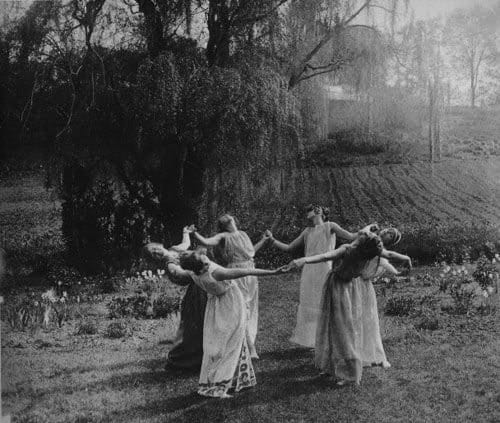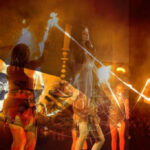Natalina | Extraordinary Intelligence
Recently, in preparation for my last podcast, (listen here) I was looking into the permeation of occultism and paganism both inside and outside of the church. During my search, I happened upon a very recent article that I found to be particularly chilling. The article was printed in The Guardian, and the title of the piece was “Season of the witch: why young women are flocking to the ancient craft.”
The thrust of the article is exactly as it sounds… our current generation of young women is finding more and more of an allure in the idea of identifying as “witch”. Now, this is nothing new, per se. Young girls have always been susceptible to this type of thing. Especially girls who feel alienated or introverted or outcast or weird. People who don’t feel like they “fit in” in general can be easy targets for deception that wraps itself in a pretty package. And witchcraft has become adept at making itself seem appealing, empowering, and exciting.
Witchcraft’s modern incarnation is called Wicca. Although practitioners enjoy claiming that Wicca itself in an ancient belief system, the truth is that it emerged in the early 1900s without much fanfare, but gained traction in the 60s during the “flower power” movement amongst hippies and feminists. Feminists in particular latched on to the concept of Wicca because of its focus on the goddess archetype that is worshiped in the practice. Wicca had no particular cannon on beliefs, so enthusiasts developed the system, borrowing from eastern mystics, druidism, Celtic lore, and various other pagan traditions.
Encyclopedia Britannica classifies Wicca as a “New Religious Movement”, meaning that it is not rooted in historical beliefs in any meaningful way. New Religious Movements are “by definition, “new”; they offer innovative religious responses to the conditions of the modern world, despite the fact that most NRMs represent themselves as rooted in ancient traditions. NRMs are also usually regarded as “countercultural”; that is, they are perceived (by others and by themselves) to be alternatives to the mainstream religions of Western society, especially Christianity in its normative forms.”
That Wicca is viewed as “countercultural” is no accident, as its earliest promoters were steeped in radical feminism and “free love”. Because hippie culture was always tied largely to Eastern mysticism and New Age philosophies, Wicca was meant to give the social and political feminist movement a “spirituality” of its own. According to the article in the Guardian:
Wicca, with its focus on a goddess (rather than a male god – though it has those too) and its relatively open approach to creating canon, was a natural fit for many feminist women interested in writing their own spiritual script.
With all of this said, clearly the practice of witchcraft even in neo-pagan forms such as Wicca is strictly a dark occult practice, and is playing with literal fire. Spells and incantations used in ceremonial magical practices rely solely on demonic and forbidden sources for their power. Witchcraft, sorcery, divination, incantation… whether presented as “Black or White”… are all forms of spiritualism that deny the need for a savior. The focus is on the self and one’s inner abilities to manifest into reality their own heart’s desires. Scripture warns of things repeatedly: Leviticus 19:31, Deuteronomy 18:9-12, Leviticus 20:6, Galatians 5:20-21, Isaiah 8:19, 2 Chronicles 33:6, 1 Samuel 15:23, Acts 19:19… and countless others.
So, why is Wicca specifically, and witchcraft in general, finding a new set of recruits amongst modern young girls?
Per usual, the most overt culprit is the entertainment industry. While the past decade saw Harry Potter introduce a wizarding world to kids everywhere, it didn’t really have the right “edge” to draw people into an actual system of beliefs. However, that changes when the target audience is an already confused and vulnerable demographic: teenage girls.
Wildly popular TV franchise American Horror Story has made a name for itself by bringing some of the most disturbing content to cable television. In its first season, a ghost story mixed with a troubling S&M bondage subplot called Murder Houseushered in the show’s popularity. Season two, called Asylum, followed patients around Briarcliff Mental Institution, where sadistic nuns and mad doctors experimented on patients, and nothing was off the table including torture, demonic possession and more. Season three shifted gears somewhat, taking its attention off of the mainly adult audience with an aim set squarely on the younger crowd. This season was called Coven.
American Horror Story: Coven is about oppression; specifically, the oppression of marginalized groups and female empowerment. Set in New Orleans, the plot imagines that since the Salem Witch Trials, witches have lived underground, hiding their true identity for fear or persecution by wicked Christians. But the craft lived on in the bloodline of their descendants. In New Orleans, there is a boarding school for exceptional young women. To the rest of the world, these girls are troubled but harmless. In reality, these are young witches who have begun to manifest their “gifts”.
The season follows around the group of girls who all feature some manner of social stigma. One is an intellectual introvert, one is an overweight African American girl, one is a former teen celebrity who has fallen into drugs, one is a young lady with Down’s Syndrome. Throughout the show, these girls learn how to harness their innate powers and as they become more adept, they become more powerful.
Just as it was when Wicca first began to flourish during the burgeoning feminist movement, it is now finding a home amongst young girls who feel like outcasts from society. Not unlike the fabled “Xavier’s School For Gifted Youngsters” from Marvel’s X-Men franchise wherein mutants are both protected from society and given a safe haven to hone their gifts, the boarding school in Coven allows young girls to harness the powers innate to their nature just out of sight of the prying eyes of a cruel world that simply cannot understand them. For young women watching this show and yearning to be seen as special, Wicca provides an appealing alternative. While there may not realistically be a coven for the girls to join, Wicca can be a solitary practice, and is taught largely through books. Author Silver Ravenwolf wrote Solitary Witch: The Ultimate Book of Shadows for the New Generation, which teaches modern young Wicca students how to practice in solitude, and the concept has immensely popular amongst Wicca adherents.
The current generation flocks to Witchcraft because of the rise in the meme about being “spiritual but not religious”. It is rebellious and edgy. It snubs its nose at polite society. It packages itself as the answer for girls (and some boys) who feel like outcasts. In fact, it tries to attach itself to all socially disenfranchised groups with startling results. The enemy certainly is cunning. Here’s a prime example, directly from the Guardian article mentioned at the beginning of this post…
The article begins by sharing the thoughts of popular rapper Azalea Banks. Ms. Banks is known for her outlandish and outrageous twitter rants, but the one that has gotten the most attention is her admission that she is a witch. Not only that, but she believes that all African Americans are naturally born witches, and that those who embrace Christianity are basically denying their mystical heritage in favor of a slave religion. Some of her quotes are as follows:
“I wonder if most of the black American Christians in the US know WHY they are Christian. I wonder if they even consider for a SECOND that before their ancestors came to the Americas that they may have believed in something ELSE.”
“But really, it’s all about magic. The most magical people are the ones who have to deal with oppression, because the non-magical are jealous. That’s why Jews and Blacks have been persecuted over and over again throughout history. because they have the most magic … all I’m trying to say is that black people are naturally born SEERS, DIVINERS, WITCHES AND WIZARDS. we have REAL supernatural powers, and the sooner we ALL learn to cultivate them and access them, the sooner we can REALLY fix sh*t.”
Then she joked that racism might end a lot sooner if black people could make their enemies sicken and die with a thought. While her comments raised the ire of many, the more disturbing part is how welcome her commentary was amongst young girls.
We’ve all witnessed how the mainstream media has been increasingly sounding the alarm about racism in America, highlighting criminal cases of alleged racial profiling and hate crime. Is it any wonder that a system of spirituality that preys upon the weak would target not only impressionable young girls, but also disenfranchised minorities?
You see, this is how the enemy operates. It isn’t always cloak and dagger back room rituals through which darkness manifests. Sometimes it is through the seemingly benign practice of honoring “mother earth” and branding a woman’s “intuition” as something beyond biology, beyond instinct, beyond experience… and turning it into something magical, mystical… special.
This article in the Guardian is a prime example of how insidious this movement is. The Guardian does not present the rise in witchcraft and Wicca as a problem, but rather as a reaction to our current society… and that it is primarily a positive one. The article uplifts witchcraft as a response to the supposedly oppressive nature of patriarchal religious systems, Judeo-Christianity in particular. The author writes, “Embracing the witchiness – deciding you can know something about your life by looking at tarot cards and listening to your hunches, or trying to affect a situation by focusing your will on it – might be just a process by which women can come to trust themselves. ”
And so, we are seeing more and more girls flocking to the haunting allure of witchery and its promises of independence, power, glamour and identity. There is even a genre of music called “witchcore”, in which musicians have little in common in terms of style but all share a specific theme – their look and lyrics are undeniably “witchy”.
The fact is, even the darkness that can be attributed to witchcraft has been repackaged as alluring. Wiccan apologists have long maintained that the accused Salem “witches” were nothing more than heroines who were simple healers and gardeners, embracing their feminine birthright of magic; and giving tribute to the inner and external goddess. According to this theory, these innocent healers were unceremoniously slaughtered by ignorant Christians who were caught up in mass hysteria. And it is true that much of what drove the Salem witch trials was ill-informed hysteria. However, last year we saw a new TV show emerge called Salem, that portrayed a fictional re-imagining of historical Salem, and it did something somewhat revolutionary in pop culture… it portrayed the Salem accused as actual witches.
 But before you presume that this means that the witches are presented in an unsavory light, let me assure you that this is not the case.
But before you presume that this means that the witches are presented in an unsavory light, let me assure you that this is not the case.
Because I try to be a student of pop culture, particularly as it relates to how the entertainment industry seeks to manipulate popular opinion and culture in general, I was intrigued by the prospect that this WGN America show was planning to portray the Salem witches as actual witches. Thus, I decided to set aside some time to watch the show. I would NOT recommend anyone else do the same. It is a graphically violent, graphically sexual, and utterly depraved show. It was also an absolute hit and is about to go into its second season.
Salem does indeed portray the persecuted women as actual witches. And not wholesome, earth loving crones. These witches are dark, sinister and linked to Satan himself.
In fact, the entire first season surrounded the witches’ plot to enact The Grand Rite.. a ritual by which all power in Salem would be shifted to the witches. The devil himself would be summoned to assist the witches in their rise to power.. But the Grand Rite required innocent blood, thus the witches, led by Mary Sibley, spend most of the season trying to trick the ignorant puritans into slaughtering innocent citizens.
Yes, these witches are bad. But, here’s the rub. While the witches are unapologetically linked to pure evil and darkness, itSalem’s presentation of HOW these women became witches that manages to cast them in a sympathetic light, and actually encourages the audience to cheer for them as they carry out their demonic deeds. In WGN’s Salem, women aren’t necessarily born witches, but they can make a pact with the devil to become a witch if they so choose. It is a binding contract that can never be broken, but in oppressive Salem under puritanical rule, selling your soul to the devil is portrayed as preferable to living as a normal puritan woman.
The Christian hierarchy, such as actual historical figures Reverends Increase and Cotton Mather, are portrayed as power hungry lunatics. While they struggle to do the Lord’s work, they are consistently falling to various temptations. Cotton (the son and protégé of Increase) is constantly drinking whiskey and frequenting the local brothel. His father Rev. Increase Mather is a sadistic preacher who takes pleasure in torturing the witches in horrific ways.
So, the moral of the story seems to be that yes.. the witches are involved in an irreversible pact with the devil, but they were driven to it by no fault of their own, but through the oppressive Christian regime that forced them into making the choice; that living under Satan’s rule is preferable to living according to the laws and customs of the puritans. And at least with the help of the diabolical dark side, the witches have some manner of power that they can wield over the cruel Christians. The below image is from a promotion for Salem, and shows precisely the message they’re attempting to get across.

Thus, what on the surface would seem to be the casting of witches in a negative light, once again is actually a clarion call to young girls who feel alienated or oppressed or ostracized from society. Even if it means the sacrificing of your very soul, at least through witchcraft you can have some amount of power that is available to you through no other means (or so they are led to believe.)
The Guardian article drives that final point home by ending with the following: “The witch, that strange woman at the edge of town – crazy, scary, ugly, disliked, but maybe, just maybe, smarter than anyone else in town – well, that’s all of us.”
For this reason, I encourage everyone who has a young person in their lives… especially vulnerable young women, to be aware of this trend. If you notice her isolating or becoming less interested in social interaction, take the time to talk to her or invite her to talk to you. Remind her that she was made in the image of God almighty, and she need not seek power or identity through the dark channels of Wicca. Let her know that no matter how alone she feels… or if she feels rejected by friends, family or society… Jesus said, “the one who comes to Me I will certainly not cast out.” John 6:37















